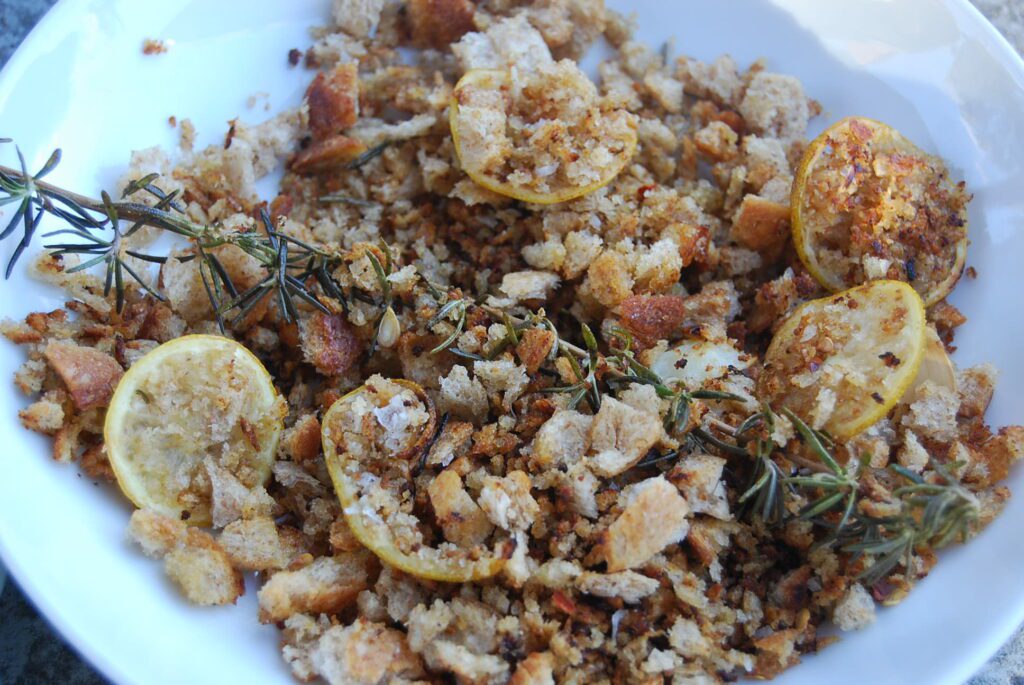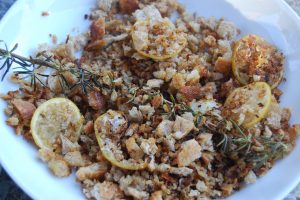
breadcrumbs – how to make, store and use
Those of you who have followed me for a while know that I hate wasting food. From planning what we eat to shopping and storing well, to using leftovers and the funny bits people don’t know what to do with – they’re all things that help reduce waste and save money. It is basically the stuff our great grandparents did without thinking but that many of us have never been taught. One of the easiest things you can do is to avoid wasting bread by storing it correctly, making breadcrumbs and learning how to use your breadcrumbs stash to make delicious meals.
A recent report from the Office for National Statistics estimated that 23 million slices of bread are thrown away in the UK every day. In the US 32% of all the bread that is produced is thrown away. Just think of all that wasted money, time, packaging, transport and landfill space. Plus all the energy that is wasted producing the ingredients for the bread. I can honestly say I never throw any bread away so here are the simple things I do to avoid waste, I hope they help you too.
How do you store your bread?
Lots of people keep bread in the fridge but the fridge actually makes bread go stale faster. Plus bread takes up so much space. Keep your bread in a container at room temperature, or even better keep it in the freezer. Because the freezer cools the bread more quickly and holds it there for longer, it doesn’t have the same effect as putting it int he fridge.
I keep our sliced loaves of bread in the freezer so it doesn’t get chance to go stale. I just toast it straight from the freezer or use the frozen bread to make sandwiches – that way they stay fresher until lunchtime.
When we have a loaf of proper sourdough, I keep it in a paper bag in the kitchen, slicing it as we use it. Real sourdough won’t go stale or get mouldy as the fermenting process helps kill off bacteria and mould. It may go a bit too dry for you to eat after a couple fo days, so just toast it, or slice it and freeze it for toast on another day.
What to do with the ends of loaves or odds and ends of unused bread
Instead of throwing ends of loaves/the odd half a naan bread or pitta away, just rip them into small chunks and put them in a bag in the freezer. You can use the chunks as croutons or make them into breadcrumbs. When the bag is full, grab it out, defrost it for an hour then whizz everything up in a food processor or Nutribullet. The crumbs can then be refrozen and used from frozen to add bulk and texture to all sorts of recipes. It doesn’t matter if you have different types of bread in there – breadcrumbs can be made from any bread.
If you are gluten-free, use good gluten-free bread.
What you can make with your breadcrumb stash
Pangrattato
Pangrattato is an Italian crunchy breadcrumb mixture, it was used instead of Parmesan in many parts of Italy. Pangrattato is a great topping when you want to add crunch to any meal. It is fab on top of a stew or risotto, or on top of green beans or broccoli.

Pangrattato ingredients
- 2 tablespoons olive oil
- 2 cloves garlic, unpeeled but squashed with a knife
- 2 handfuls stale breadcrumbs, you can use them straight from the freezer
- 1 stem of rosemary
- sea salt, freshly ground black pepper, red chilli flakes to taste
To make:
- Heat the oil in a frying pan on a medium heat and add the whole peeled cloves of garlic, a pinch of chilli flakes and the stem of rosemary. Cook for a minute or two to flavour the oil.
- After a minute, add the breadcrumbs and stir to combine.
- Continue to cook on a medium heat for around 5 minutes, stirring every minute or so until it smells toasty and garlicy and rustles dryly when you shake it.
- Take off the heat and add salt and pepper to taste. Set aside.
Recipes
Here are some of my favourite recipes that use frozen bread chunks and crumbs:
Sign up for more
Sign up for my free newsletter. You’ll get free seasonal recipes, tips and videos. You’ll also be first to hear about my online and in person courses.
I agree to be emailed about your products and services
